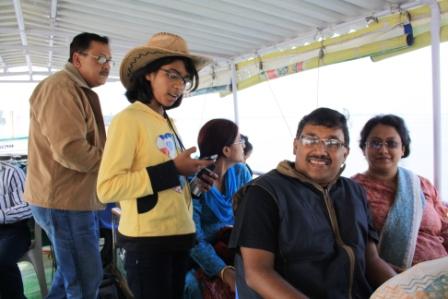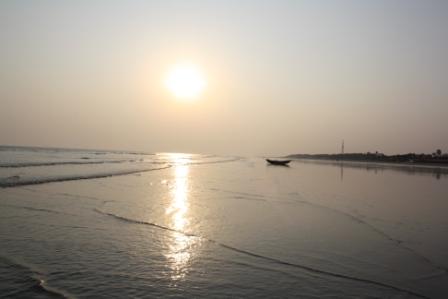RANTHAMBORE
NATIONAL PARK-MEMORIES ETCHED IN WILDERNESS
We have all grown up
hearing the famous quote from William Blake “Tiger! Tiger! Burning bright/In
the forests of the night/what immortal hand or eye ! could frame the fearful
symmetry.” The mere thought of seeing these majestic creatures in their natural
habitat instills a feeling of awe and grandeur unparalled by any other wondrous
sight of nature. With these mixed feelings we decided to visit the grandiose
Ranthambore National Park about 130Km from Jaipur because I believe that the world is a book, and those
who do not travel read only a page
Jaipur to Ranthambore
by road( October to june)
We set off by car (leave by breakfast to catch the afternoon
safari) taking the more hospitable road via the MI road (the central road of
Jaipur which separates the old city from the new) straight to Dausa. The road
from Jaipur to Dausa is a world class sixlane highway where you can whiz past
the 65 km in about an hour in a comfortable pace, the stretch has lots of
watering holes, petrol pumps and a colorful Rajasthan countryside. The type of
clothing you are going to carry is determined according to the time of the year
you are planning to visit- while a thin T-shirt would suffice during the hot
summer months, it gets really chilly
during the winter months when you have to carry real warm clothing, carry your
sunscreens, a wide straw hat, binoculars and camera with a zoom lens because animals give me more pleasure
through the viewfinder of a camera than they ever did in the crosshairs of a
gunsight,and after I've finished "shooting," my unharmed victims are still
around for
others to enjoy . It is best to visit the park as soon as it
opens in October because soon after the rains the park is teeming with wildlife
and plenty of water holes and therefore the chances of sighting a tiger
increases fourfold.
Just before you enter
Dausa a small road on the right side leads you thru the town to a place called
Lalsot-ask directions inside Dausa , because it’s a little confusing. The road
to Lalsot is a normal single lane freeway well maintained , the country side is
a mix of lovely bucolic wilderness of typical Rajashan countryside and it would
take about two hours to traverse the remaining 70km. This road will take you
straight to the town of Sawai Madhopur and Ranthambore which are twin cities.
At Ranthambore
As soon as you enter
the town of Swaimadhosingh you cross a huge flyover transecting the city ,take
the first left turn as soon as you cross the flyover ,suddenly you are into
tiger country of Ranthambore. The RTDC tourist centre is on the right side and
a host of hotels of different hues, budget and shapes line the left side of the
road.
The main aim as soon as you enter Ranthambore is to make a
beeline for the evening safari (starts at 1400hours) ticket at the RTDC centre
as only government approved vehicles can enter the park
The tourist centre was in its
characteristic turmoil with tourist vying over each other to get a safari
ticket, the omnipresent middleman and touts hovering around you ,and by the
time you come out victorious your patience starts running thin( I hope the
government makes the booking online to mitigate the sufferings of common man
and especially the foreign tourists who are innocent victims of the touts fleecing
them away ruthlessly )-the safari can be enjoyed on either open maruti jeeps of
six seater capacity or canters of twenty seater capacity (Rs375-420/-per head) and the best part was they call you to the
canter/jeeps as “char Indian/teen foreigner’ as if carrying a choice of fodder
for the tigers at the park. Apparently the park is divided into four zones with
each supposed to have 10 tigers and it is up to your luck and lottery as to
which zone you would be allotted. It is also preferable to book a canter as it
gives an elevated and wide angle view of the safari. Secondly the safari takes
place twice a day , one during early morning hours(5:30-6:00AM) and second
during the afternoon from 02:30-3:00PM) for an average duration of four hours.
The Hotels
As soon as we got our
evening safari tickets we walked into a budget hotel just opposite the RTDC. Do
not book online as you get much better deals by on ground bargaining. The rent
for the decent hotels range from Rs800/ (roadside single rooms) to Rs 2000/ (individual
cottages) complete with a small swimming pool, bar, AC,broadband connection and
breakfast thrown in for free.Try to stay as near to RTDC centre as possible to
facilitate pickup by the safari vehicles. Initially the vehicles used to pick
one up from the hotels but now it is mandatory to board at the RTDC centre
where you bought your ticket.
Safari (Oct to
Jul)
The canter with the guide set out exactly at 1400 hours and
we were a mixture of motley crowd of twenty on the trip ranging from an elderly
American couple, NRI Indians and young students from a Jaipur college.
As you enter the park the towering Ranthambore fort seats at
the entrance as a mute spectator (a visit to the Lord Ganesha temple is a
must), a sense of mystique, trepidation and apprehension albeit a little chill
which was more because of the cool environs embraces you. The park is built
alongside a mountain range which looks like a huge savannah dotted with large water
bodies, old dilapidated hunting lodges bearing a testimony of the carnage
carried out on the humans and the wild life by the so called royalty. The four
hour drive was an experience in itself. It was rejuvenating, exhilarating out
of the world experience where we came about hordes of wildlife in their natural
habitat roaming around fearlessly and included langurs,
Jackals, Black bucks,Chinkara, Civets and Common mongoose. The park also
has a large number of marsh crocodiles bathing about lazily in the sun
besides the tiny rivulets which crisscross the park.Not only that it also has a
veritable collection of flora and fauna, a botanist’s delight but a huge
collection of the winged variety the
Graylag Goose, Woodpeckers, Indian Gray Hornbills,
Common Kingfishers,Flamingos, Ibis, Pelicans, Storks, Pittas, Shrikes, Treepies
to name a few making the park a birdwatchers delight. As our canter
crisscrossed the landscape driving deep into the belly of the park,the sight
which awaited us would be etched in memory till we meet our maker. As our
canter was passing a small rivulet the guide suddenly beckoned us to keep our
trap shut and the canter stopped to a halt-it was as if the whole world had
come to a sandstill, the gazelles stopped on their tracks paralysed with fever
and reverence, the langurs quietly scuttled away and for a moment even the
birds stopped chattering-two tiger cubs slowly moved down the hillside along
with their mother to have a bathe and an evening drink from the waterhole,after
having feasted on a gazelle, for a moment time stood still we even forgot to
lift our cameras as the two
tiger cubs made their way to the waterhole looking around in disdain with the
attitude of true royal blood on their evening walk. The long golden rays of the
setting sun reflected off their beautiful chequered skin giving a golden hue
and they sat down inside the water hole in true royal style when a silent
prayer sprang to my lips –‘May your world ever stay beautiful, your actions
majestic, your nature merciful and your kingdom bountiful” . As the darkness begin
to creep in the sudden revving of the canter engine broke our reverie and
despite our yearning to stay back we had to make our way out of the park to our
hotel room.
Before we left Rantambore we collected a memorabilia of tiger
engraved T-shirts and caps to keep the moments alive because just as we do not remember days, we
remember moments.
We
have enslaved the rest of the animal creation, and have treated our distant
cousins in fur and feathers so badly that beyond doubt, if they were able to
formulate a religion, they would depict the Devil in human form. ~William
Ralph Inge, Outspoken Essays,
1922






































